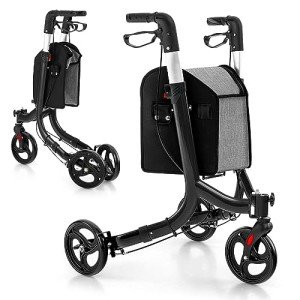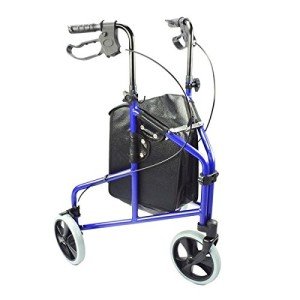
17
mayoThe 10 Most Dismal How To Use A Rollator Failures Of All Time Could Have Been Prevented

How To Use A Rollator: A Comprehensive Guide
Rollators are mobility aids created to improve the independence and safety of individuals with mobility challenges. Unlike basic walkers, rollators are equipped with wheels, a seat, and often a storage pouch, enabling users to move with greater ease and Drive Devilbiss Tri-Walker: Comfort & Support on the Go. This article offers an in-depth guide on how to use a rollator efficiently and safely, guaranteeing a smoother and more satisfying walking experience.
What is a Rollator?
A rollator is a wheeled walking aid. It generally has:
- Three or 4 wheels: Offering stability and maneuverability.
- Hand brakes: For control while walking or when resting.
- A seat: Allowing users to take breaks easily.
- Storage space: Such as a basket or pouch for personal items.
Types of Rollators
There are different types of rollators, designed to meet the needs of various users:
| Type | Description | Best for |
|---|---|---|
| 3-Wheel Rollator | Lighter and more compact, ideal for indoor use | Navigating tight areas |
| 4-Wheel Rollator | Deals stability and a bigger seat, suitable for outdoor use | Longer strolls and heavier use |
| Durable Rollator | Designed to support more weight with extra robust features | Users needing additional assistance |
| Pediatric Rollator | Smaller in size, changed for children | Children with mobility limitations |
How to Use a Rollator
Using a rollator properly is vital to guarantee safety and maximize the benefits it provides. Here's a detailed guide:
Step 1: Adjust the Height
Before using the rollator, it is vital to adjust the handlebars to the proper height.
- Stand directly: With your arms relaxed at your sides.
- Procedure the height: The hand grips need to be at wrist level when the user is standing.
- Protected modifications: Ensure all locking mechanisms are firmly engaged.
Step 2: Familiarize Yourself with the Rollator
Comprehending the elements of the rollator will assist improve its usability.
- Brakes: Learn how to engage and launch the brakes by squeezing the handles.
- Seat: Identify where to sit easily when you require to rest.
- Storage location: Know where you can store individual belongings.
Step 3: Start Walking
- Position the rollator: Place it an action ahead of you, guaranteeing that the brakes are launched.
- Grip the handles strongly: Keep a light stress in your arms while holding onto the rollator.
- Step inside the frame: Move forward by stepping with one foot and then the other.
- Maintain a straight posture: Walking ought to be upright, avoiding the temptation to lean on the rollator exceedingly.
Step 4: Utilize Brakes
Constantly use the brakes efficiently to improve safety:
- To decrease: Gradually squeeze the brakes.
- To stop: Fully engage the brakes by pulling on both manages.
- To sit down: Ensure the rollator is stable, then carefully lower yourself onto the seat.
Step 5: Maneuver with Care
Turning and browsing can be tough, so here are important ideas:
- Telegraph your instructions: Look where you wish to go before turning.
- Take little actions: Move carefully when turning to keep balance.
- Use a three-point turn: Turn from one side to the other, keeping the Homecraft Walker Trolley: Wheels & Trays for Ease close.
Step 6: Practice Stopping and Resting
Taking breaks is essential. Here are tips for resting:

- Find flat surface areas: Ensure the location is level when you sit.
- Engage the brakes when seated: This will avoid rolling.
- Shift position slowly: When ready to stand again, eliminate the brakes before rising.
Upkeep and Safety Tips
To make sure the rollator stays functional and safe:
- Regularly examine the brakes: Ensure they engage and release correctly.
- Inspect wheel alignment: Wheels should not wobble; tighten up any loose screws.
- Tidy the rollator: Wipe down surfaces and remove particles from tires to maintain smooth operation.
Typical Concerns
Users may face numerous typical problems when using rollators. Here are some general FAQs:
FAQs
Q1: Can I use a rollator outdoors?A: Yes, many
rollators are created for both indoor and outdoor use. Nevertheless, ensure it has the proper wheel size and tread for outdoor surfaces. Q2: What are the weight limitations on rollators?A: Weight restricts
usually differ by model, but durable rollators can normally accommodate users weighing around 300 to 500 pounds. Q3: Are rollators adjustable?A: Yes, a lot of rollators come with adjustable manage heights to accommodate users of various heights
. Q4: How do I transfer a Rollator For Walking?A: Many rollators canbe folded for hassle-free transport in a car. Constantly check the user manual for particular Lightweight Folding Walker with Seat & Brakes guidelines. Q5: Can I use a rollator while recuperating from surgery?A: Yes, lots of individuals use rollators throughout recovery to regain strength and balance, but ensure you follow your doctor's advice.
Understanding how to use a Rollator With Wheels properly can substantially improve mobility and decrease the risk of falls. Whether you are brand-new to utilizing mobility aids or looking to improve your strategy, following the guidelines gone over in this article is crucial. With practice, a rollator can improve independence while ensuring safety, thus allowing users to take pleasure in a more active lifestyle.


Reviews